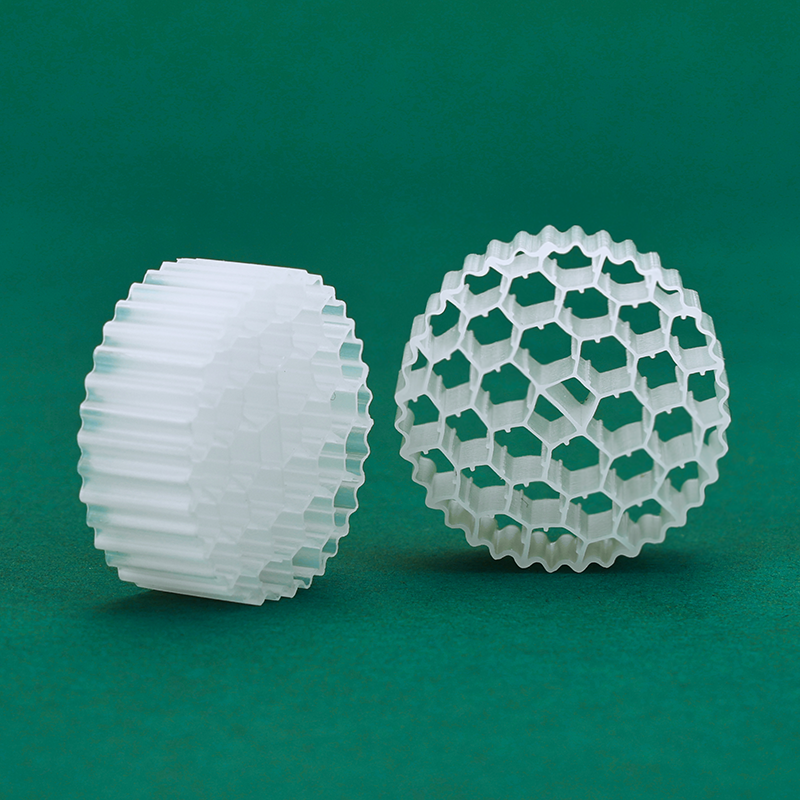 +86-15267462807
+86-15267462807
When it comes to MBBR media materials, polypropylene (PP) and high-density polyethylene (HDPE) are the two heavy hitters. Both offer excellent properties for wastewater treatment, but they have some key differences.
Advantages:
Versatility: PP can be molded into various shapes and designs, maximizing surface area for biofilm growth. This flexibility allows for customized media specific to treatment needs.
Efficiency: PP media is known for efficient removal of organic and inorganic pollutants.
Cost-Effectiveness: PP can be a more affordable option compared to HDPE, especially in large-scale applications.
Disadvantages:
Initial Cost: While generally cheaper than HDPE in the long run, the upfront cost of PP media might be slightly higher.
Chemical Resistance: While good, PP's chemical resistance might be slightly lower than HDPE in extreme conditions.
Advantages:
Durability: HDPE is exceptionally strong and long-lasting, making it ideal for demanding wastewater treatment environments.
Superior Chemical Resistance: HDPE can withstand exposure to a wider range of chemicals compared to PP, ensuring durability in harsh chemical environments.
Disadvantages:
Cost: HDPE is generally more expensive than PP, especially for large quantities.
Versatility: While shapes can be created, HDPE might offer less flexibility in design compared to PP.

The ideal material depends on your specific needs:
For cost-conscious applications and when customizable shapes are desired, PP might be the better choice.
If durability and chemical resistance are paramount, particularly in harsh environments, HDPE is the way to go.
| Feature | Polypropylene (PP) | High-Density Polyethylene (HDPE) |
| Cost | Generally more affordable | Generally more expensive |
| Versatility | More flexibility in shapes and designs | Less flexible in designs |
| Chemical Resistance | Good chemical resistance | Superior chemical resistance |
| Durability | Good durability | Exceptional durability |
| Biofilm Growth | Supports biofilm growth | Supports biofilm growth |
| Maintenance | Might require more frequent cleaning | Less frequent cleaning required |
Polypropylene (PP):
General Wastewater Treatment: Due to its affordability and good overall performance, PP is a popular choice for various municipal and industrial wastewater treatment applications. Its versatility in shapes allows for optimization for different types of pollutants.
Biological Nutrient Removal: Some specially designed PP media can be effective in removing nitrogen and phosphorus alongside organic matter through biological processes.
Low-Strength Wastewater: For wastewater with lower pollutant concentrations, PP's cost-effectiveness makes it an attractive option.
High-Density Polyethylene (HDPE):
Industrial Wastewater Treatment with Harsh Chemicals: In industrial settings where wastewater might contain aggressive chemicals, HDPE's superior chemical resistance makes it the preferred choice to ensure durability and maintain treatment performance.
High-Strength Wastewater: For wastewater with high concentrations of pollutants, HDPE's strength becomes crucial to withstand the demanding environment. This can be relevant in industries like chemical processing or paper manufacturing.
High-Temperature Applications: Some HDPE formulations can withstand higher temperatures compared to PP. This might be important in specific wastewater treatment processes with elevated temperatures.
| Application | Ideal Material | Considerations |
| General Wastewater Treatment | PP | Cost-effective, good overall performance |
| Biological Nutrient Removal | PP | Specific designs for enhanced nutrient removal |
| Low-Strength Wastewater | PP | Cost-effective for lower pollutant concentrations |
| Industrial Wastewater with Harsh Chemicals | HDPE | Superior chemical resistance for harsh environments |
| High-Strength Wastewater | HDPE | Strength to withstand demanding conditions |
| High-Temperature Applications | HDPE (specific formulations) | Handles higher temperatures compared to PP |
Biofilm Growth: Both PP and HDPE can support healthy biofilm growth. However, some surface modifications might be used on either material to further enhance biofilm adhesion and growth rates.
Maintenance: Regular cleaning of MBBR media is important for optimal performance. The surface characteristics of PP and HDPE can influence cleaning requirements. PP might require more frequent cleaning due to potential adhesion of inert materials compared to HDPE.